It’s a safe assumption that if you are an EngineLabs reader, then you are all about horsepower. We are too. So it’s not unusual that any discussion about engines will quickly evolve to estimates of power. That’s what everybody wants to know. Over the years of building and testing engines for the street and competition, this game has evolved with ever-escalating horsepower numbers.
One of our favorite places to test engines is at Westech Performance. Often, right before we were about to abuse our latest effort, the question that dyno operator Steve Brulé would ask is “How much do you think it will make?” If there were several observers in the room, we’d all make our best guess and Steve would almost always be the most accurate.
I knew he had lots of experience with engines since he tested them nearly every day. But after much prodding, he eventually revealed the simple equation that he uses to estimate power for a good street engine. But before we reveal the equation, let’s first run through some basics on how the equation works.
It’s All Math
The cliché line is that internal combustion engines are nothing more than air pumps. The more air a normally aspirated engine can move through the cylinders and successfully capture, the more cylinder pressure and power the engine can make. So not surprisingly, airflow is a critical element that determines the amount of power. This story and the equations within are aimed at street engines with decent cylinder heads and street/strip-style cam timing. Although, the equation can be used for higher output normally aspirated competition engines, as you’ll see it just needs a different multiplier.
Other important variables include compression ratio and cam timing. As we will show, all of these components are important ingredients that help determine a given engine’s power potential. This discussion will focus mainly on street engines running on pump gasoline with an octane rating between 91 and 93. We will also touch briefly on supercharged applications using pump gas.
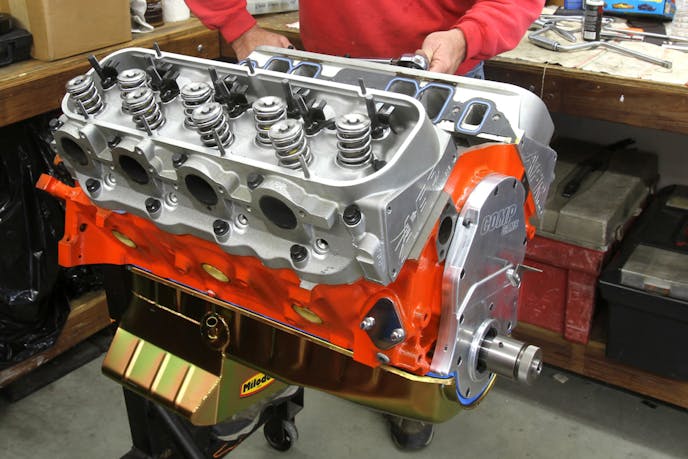
Now we can get into the equation. We should also point out that we ran across this same equation during a discussion with Ben Strader, the man behind EFI University, who uses this equation as part of his course on race-engine technology. The initial portion of this equation is an estimate of the amount of peak torque an engine can make per cubic inch. For the basis of this discussion, we will use a number between 1.25 and 1.30 lb-ft of torque per cubic inch.
As an example, we have a 468ci big-block with good oval port heads, a dual-plane intake, 750cfm Holley carburetor, and 1-7/8-inch primary tube headers. The first part of the equation would be:
If we were working instead with a 302ci small-block Ford, the peak torque number would be 377 lb-ft. This smaller engine illustrates how displacement limits torque capacity. The little 302 would have to make 1.937 lb-ft of torque per cubic inch to achieve what the 468 can produce.
Through decades of engine testing, a typical result is that normally aspirated engines lose roughly 10-percent torque between peak torque and the peak horsepower RPM points. This is not a set-in-concrete number, as we will see, but it is an easy way to help estimate horsepower. If our big-block is making 585 lb-ft and loses 10-percent of torque at the peak-horsepower RPM point, we can quickly calculate that number with this next step:
Now that we know the engine’s torque value at its peak RPM point, this is where we have to do some educated guessing regarding peak horsepower RPM. This is where the cam timing numbers begin to play a part. If our engine is equipped with a roller camshaft with longer duration numbers than stock, this will push the engine’s peak RPM point higher than stock. Let’s investigate why this happens.
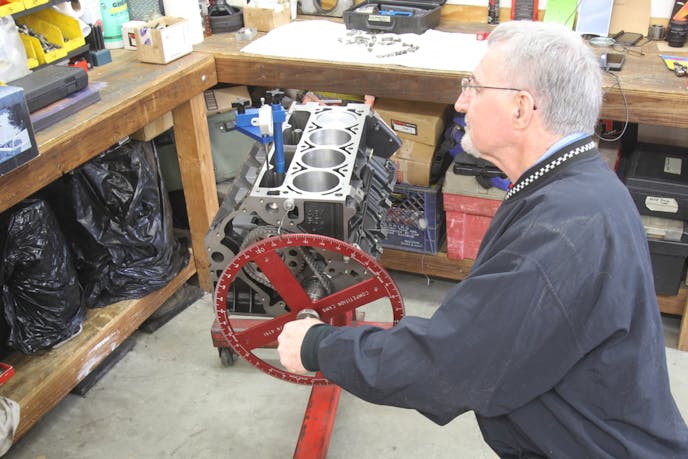
A longer duration camshaft offers an engine more time (in duration numbers) to pull more air into the cylinders at higher engine speeds. A short-duration cam will close the intake valve much earlier compared to a longer duration camshaft. An early intake closing will limit high-RPM power. By lengthening the duration, this allows the engine to fill the cylinders and make more power at a higher engine speed. So, if our engine is an unknown quantity, but we do know the cam duration specs, we have some data to help us determine how high the engine will spin to achieve peak horsepower.
Continuing with our 468ci example, let’s say our camshaft is a 282/288 advertised duration hydraulic roller with 230/236-degree at 0.050 numbers and a mild 0.510 / 0.520-inch lift. For a big-block Chevy, these are conservative numbers, so we can be fairly confident that peak horsepower will occur below 6,000 rpm. Let’s use 5,900 rpm as our peak horsepower RPM point.
This RPM number is important for the final part of our power estimate – the classic horsepower equation:
So now let’s add in all our numbers:
Calculated Numbers vs. Observed Numbers
We chose this particular engine as our example because we have numbers from Westech’s engine dyno from a test that was done years ago with help from COMP, where we tested three different camshafts to show the effect on the torque curve. This 468ci Rat with the aforementioned camshaft grunted 581 lb-ft of torque at a rather low 3,900 rpm and 527 horsepower at 5,800 rpm.
Comparing the real, measured torque figure of 581 lb-ft, we can see that our estimate of 585 lb-ft was amazingly close. However, the engine didn’t do quite as well when it came to peak horsepower since the torque fell off to 477 lb-ft at 5,800 rpm. That 477 lb-ft number calculates to an 18-percent lower figure compared to peak torque. So clearly, this big-block is suffering from limitations either on the inlet side or perhaps it needs improved exhaust-port flow.
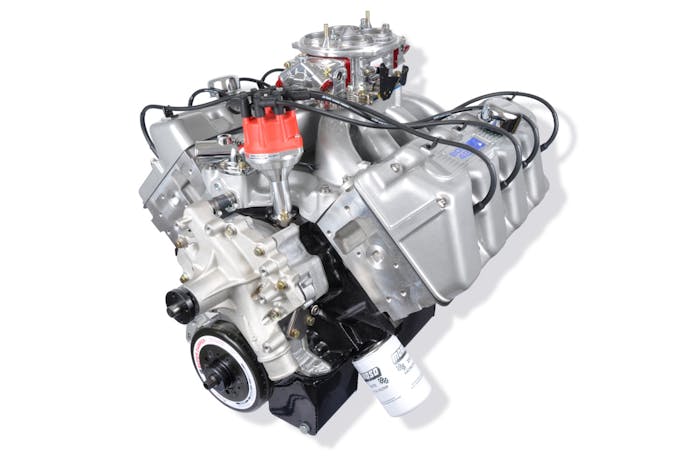
The equation uses several assumptions that, as we’ve seen, can often miss the engine’s actual numbers. But as a generic estimate that you can use to amaze your friends with your internal combustion engine knowledge, it will probably be more accurate than friends who merely yank a number out of the clear blue sky.
A good student of the internal combustion engine can see a raft of variables present in this equation. The biggest assumption is torque per cubic inch. While 1.25 per cubic inch is a decent number, we see street engines every day that far exceed this number. One such over-achieving example is Jon Kaase’s killer Boss9 engines using his version of the hemispherical Boss Ford heads.
On pump gas, Kaase’s 429-based 521ci stroker mule engine with a single four-barrel carb on pump-gas regularly makes 730 lb-ft at peak torque. That, friends, is 1.40 lb-ft of torque per cubic inch. Plus, this monster makes over 910 hp at 7,000, losing only 7-percent between peak torque and peak horsepower.
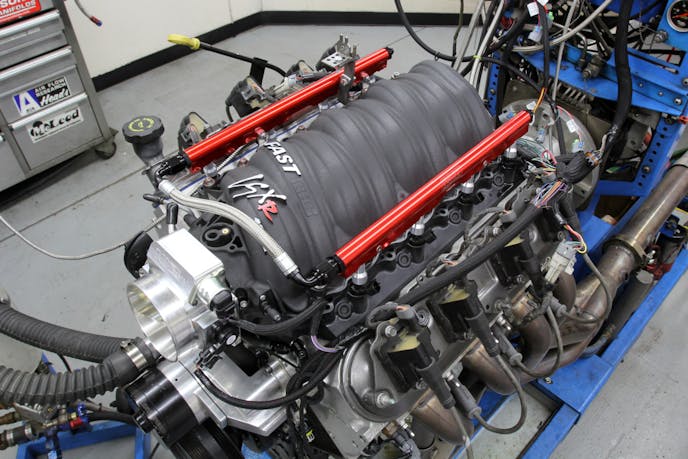
This is where it takes some skill and engine knowledge to know how much to estimate. As a further example, Kaase told us that the Engine Masters competition engines often generate 1.50 lb-ft of torque per cubic inch numbers. If our 468 Rat could generate a 1.5 lb-ft per cubic inch, that would push the peak torque to 700 lb-ft!
As another example, several years ago we tested a used 6.0L iron short block LS with a final configuration of 10.0:1 compression, a set of TFS aluminum cathedral port heads, a COMP hydraulic roller camshaft with 227/234 degrees of duration, and FAST’s excellent LSXr intake manifold. This engine made outstanding torque with 501 lb-ft at 5,300 rpm. That calculates out to 1.37 lb-ft of torque per cubic inch. We plugged 90-percent torque (451 lb-ft) at the 6,700 peak power RPM into the horsepower formula, and that spit out a number of 575 horsepower. While our engine managed only 557 horsepower, that’s within 18 horsepower — a mere 3-percent error factor.
Adding Forced Induction
Let’s shift our attention to supercharged engines. If we think first in terms of theoretical power, a supercharger uses pressure to push additional air (and fuel) into the cylinders. Again, these details will focus only on mild street engines that have to rely on 91- to 93-octane AKI (anti-knock index) pump gas. Assuming none of the parasitic losses required to drive a supercharger, if we add 14.7 psi of boost to an engine, this would be the equivalent of doubling the displacement of the engine.
This occurs because we have doubled the pressure pushing air into the engine. This adds another 14.7 psi to atmospheric pressure at sea level. So, if a 350ci engine makes 430 lb-ft of normally aspirated torque, a supercharged version with 14.7 psi could make around 860 lb-ft. Realistically, this wouldn’t happen because a supercharger at 14psi will demand a minimum of 50 to 75 horsepower just to spin the blower — perhaps even more. But the theoretical combination is still making around 800 lb-ft at peak torque.
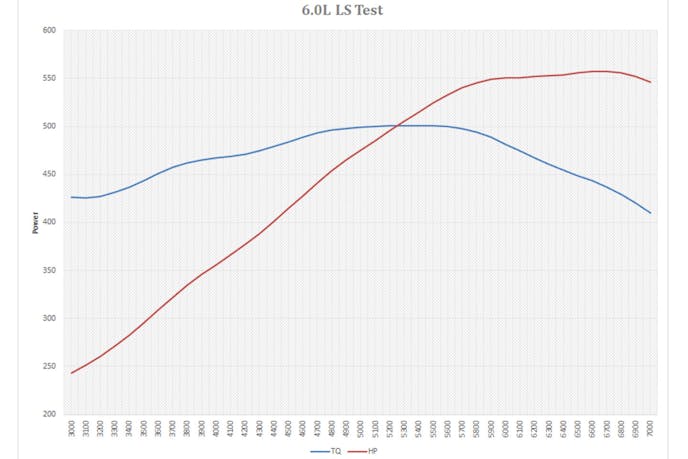
As a quick aside, a turbocharger at the same boost level would probably fall somewhere in between the 800 and 860 lb-ft numbers. While a turbocharger doesn’t have the same parasitic losses (mainly exhaust backpressure and charge temperature increases), there are still some to be accounted for.
The major problem here is that 91-octane fuel will not allow those big numbers to occur. The cylinder pressure, even at a 9:1 static compression ratio with 14 psi of boost, would be too high and the engine would detonate. One option might be to increase the octane of the fuel you’re using. Recently we published an article about mixing pump gas and E85 to gain octane. Alternatively, you could lower the boost.
If we lower the boost to something a bit more conservative, like 7 psi or roughly half an atmosphere, pump-gas should be able to accommodate this increased cylinder pressure. Again from a theoretical position, this would equate to a 50-percent increase in torque, or roughly 645 lb-ft in our make-believe engine, minus the power required to spin the supercharger.
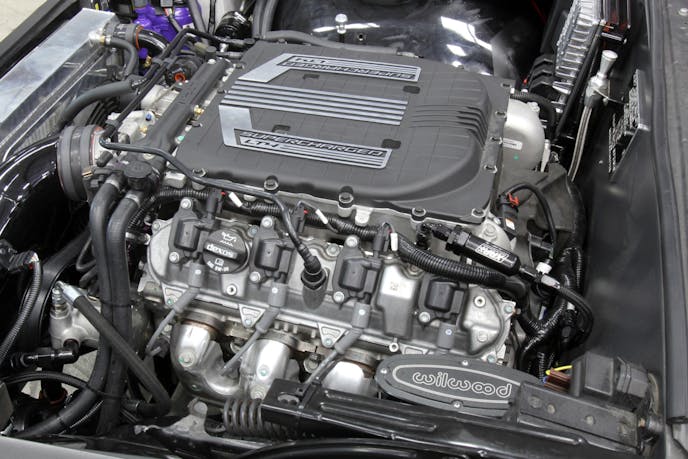
To swing this back into the practical world, let’s look at two similar Chevrolet Performance crate engines: the direct injected LT1 and the supercharged LT4. since both engines displace 376 cubic inches. The normally aspirated LT1 makes 465 lb-ft of torque, which equates to 1.23 lb-ft per cubic inch. The LT4 supercharged crate engine uses a shorter duration camshaft and a lower compression ratio (10:1 versus the LT1’s 11.5:1) but uses similar heads. The LT4 employs an efficient Eaton R1740 TVS roots-style blower to make 8psi of boost.
The blown LT4 produces a stout 650 lb-ft of torque. If we assign that 8psi as roughly half an atmosphere, then that should produce a 50-percent increase in torque. The actual increase between the engines is right at 41-percent. But we must also account for the power sacrificed to turn the blower. With that added in, the numbers turn out to be quite close.
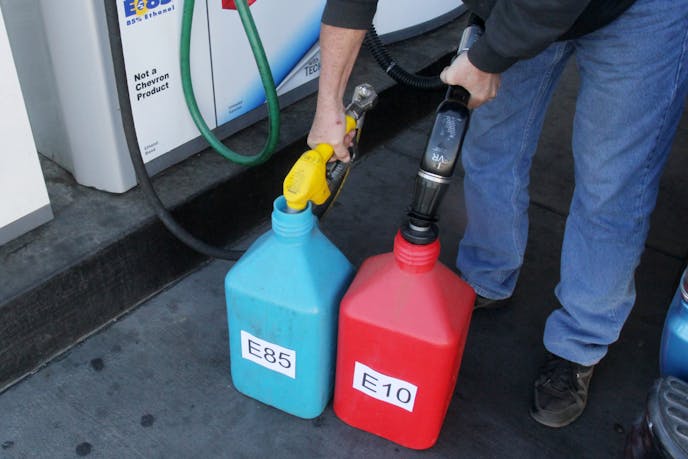
The LT1 is rated at 460 horsepower while the LT4 is listed at 650 horsepower which is also right at a 41-percent over the normally aspirated version. So the point is that with a street supercharger and an engine with decent airflow characteristics — like good heads and intake manifold — a street blower pushing 8psi should be worth around a 40-percent increase in observed power.
We’ve moved pretty quickly through this automotive garden of verses and have made some fairly large assumptions about airflow, camshafts, and engine friction — and we didn’t even touch on supercharger efficiencies. Nevertheless, equipped with this simple engine performance equation, you should be able to come pretty close in estimating the power potential for most engines. Except for those nitrous guys. That’s a whole different story.
You might also like
SEMA 2025: Melling DOD-delete kit Now Includes Emissions Tuning
Melling adds tuning to the DOD-delete kit. This package for LS/LT engines includes the hard parts and an HP Tuners tool.







